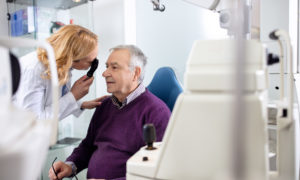
Nov. 11, 2015
The role you play in the care of diabetic patients is significant, findings of a recent study suggest. According to the UnitedHealthcare study, “Impact of Eye Exams in Identifying Chronic Conditions,” diabetes was diagnosed as the result of an eye exam in 15 percent of the cases studies from 2011 to 2012. As the Vision Source 2015 Navigation Guide to Health Care Reform points out, ODs perform comprehensive eye exams on millions of diabetic patients every year. In a typical optometric practice with 5,000 active patients, there are likely to be 450-500 diabetics.
Stage 3 of Meaningful Use kicks in January 1, 2016. Stage 3 of Meaningful Use is all about improved outcomes. We need to be thinking about how to improve the outcomes of our patients. Patients with diabetes is one very important area that we need to address.
Are you a team player helping to improve the outcomes of patients with diabetes? One of the issues that we need to understand is that when the general physician (GP) is audited by a third party, the GP is penalized if they cannot show documentation that an annual dilated fundus examination happened for every diabetic patient in their files. The documentation you send to the GP helps them pass their audits. If you don’t do an annual dilated fundus examination of patients with diabetes, or if you did one, but did not communicate it to the GP, then you are not viewed by the GPs as helping them pass their audits. It would be a natural response for the GP to send patients with diabetes to eye doctors who are going to be team players.
Another issue to be considered is that half of all diabetics have yet to be diagnosed. They have the condition, but no one has yet diagnosed them. The primary focus for the best long-term outcomes of diabetes is good blood sugar control. Good blood sugar control cannot happen when the diabetic has not yet been diagnosed, so it is imperative that we help identify patients with undiagnosed diabetes as soon as possible, and then get them to the appropriate physician for diabetic treatment.
Let’s quickly review the symptoms, fasting blood glucose levels and A1C values symptomatic of diabetes.
The four classic symptoms of diabetes are:
• increased thirst
• frequent urination
• unexplained weight loss
• tingling of hands or feet
Understanding fasting blood glucose level is a core concept to diagnosing diabetes. For people who do not have diabetes, normal fasting blood glucose levels are between 70 and 100 milligrams per deciliter (mg/dL). A person with pre-diabetes has a fasting blood glucose between 100 and 125 mg/dL. A person with diabetes has a fasting blood glucose level of 126 mg/dL or higher. Typically, the diagnosis of diabetes is made when two separate fasting blood glucose levels show numbers of 126 mg/dL or higher.
There are some people who have normal fasting blood glucose levels, however, because of impaired glucose management, their blood glucose levels rise too fast when they eat. The test that is run for this condition is called the casual blood plasma test. This test is not a fasting test. Normal readings for blood sugar two hours after eating should be less than 140 mg/dL. This test, when it shows repeated results over 200 mg/dL, suggests diabetes.
The American Diabetes Association’s goals for blood sugar control in people with diabetes are:
• 70 mg/dL to 130 mg/dL before meals
• less than 180 mg/dL after meals
Another test for diabetes is called by several names: glycated hemoglobin, glycosylated hemoglobin, hemoglobin A1C, A1C, A1C, and HbA1c. All of these are the same test. The A1C test also does not require fasting. It measures the attachment of glucose to hemoglobin. Red blood cells typically live for three months, therefore, the A1C test reflects the average blood glucose levels over the last three months. The A1C is reported as a percentage. An A1C value of 5.7 percent, or below, is considered normal. Pre-diabetes have an A1C result of 5.7-6.4 percent. Diabetes is when the A1C is 6.5 percent, and above, on multiple testings.
Diabetics have their A1C tests run at least 2-4 times per year. Make sure your patients with diabetes are keeping up with their blood workups.
You should know that people with pre-diabetes are likely to develop type 2 diabetes within 10 years.
What can we do? We can easily put the four symptoms of diabetes on our pre-examination history checklists. We can also easily ask patients on our pre-examination history questionnaires if they have had a fasting blood glucose test within the last year or an A1C test, and if they have, what are their scores? For at-risk patients, we can order a fasting blood glucose test or an A1C, or, at the very least, communicate with the general physician our concerns, asking them to order the test.
Once a patient has been identified as diabetic, it is important to make sure that we are at least doing an annual dilated fundus examination. It is not enough to just do the annual dilated fundus examination; it is essential the results are communicated to the other doctors caring for the patient, such as the general physician and/or the endocrinologist. And don’t stop there – for our patients who have been diagnosed with diabetes, we need to make sure they are compliant with managing their condition.
Since Stage 3 of Meaningful Use is all about improved outcomes, let’s take this week to make sure that we are helping our diabetic patients have improved outcomes. Here are three steps to take today:
1) Review your pre-examination history questionnaire making sure it addresses the diabetic issues we’ve discussed in this article.
2) Make sure every one of your patients with diabetes has an annual dilated fundus examination.
3) Review your communication protocols with physicians about your patients with diabetes. Make sure you are a team player by being actively involved in co-managing these patients.
To read more about diabetes and testing for diabetes, go to these web sites:
National Institute of Diabetes and Digestive and Kidney Disease
WebMD Diabetes Health Center

























